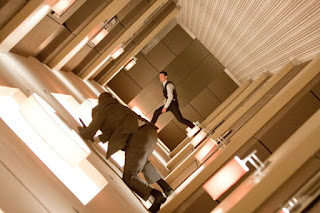Media Language refers to the ways in which meaning is created in media texts.
Establishing Shot: The opening shot in a dramatic scene that establishes the disposition of people and objects in the mise en scene. As such it is usually a wide shot, and is likely to be followed by a succession of closer shots.
Point of View Shot: A camera angle in which the viewer seems to see with the eyes of the character in the scene.
Over the Shoulder Shot: A camera shot in which the subject of the shot is filmed from behind a person's head and shoulders, which are framed to one side in the foreground.
High-Angle Shot: A camera shot taken from a higher level than the subject, and angled down towards them. This shot can have the effect of diminishing the authority of the subject, making them look weak.
Low-Angle Shot: A camera shot taken from a lower level than the subject, and angled up at them. This shot can have the effect of enhancing the authority of the subject, making them look powerful.
Canted Angle: A cinematic device where the camera is physically placed at and angle so that vertical and horizontal surfaces appear diagonal.
Pan: A horizontal camera movement left-to-right or right-to-left on a fixed axis. The word is short for 'panoramic movement'. A pan following a moving object suggests we are viewing it from the point of view of an observer.
Tracking Shot: A camera movement achieved by mounting the camera on a dolly and moving it along a track. Typically, tracking shots are used to follow characters or other objects in motion.
Diagetic Sound: Sound that can be heard by the characters in the world of the film.
Diagetic Sound: Sound that can be heard by the characters in the world of the film.
Non-diagetic Sound: Sound that cannot be heard by the characters in the world of the film.
Synchronous Sound: Sound that is directly matched with what is being viewed.
Sound Bridge: Editing technique in which visual cuts are deliberately not matched with audio cuts. For example, the editor may cut to a completely new scene, but allow sound from the preceding scene to run on for a short time. Alternatively, we may hear the sound of the next scene before we can see it.
Dialogue: The conversation that happens between characters in a work of fiction, or the lines spoken by actors.
Voiceover: A type of non-diagetic, asynchronous sound in which the audience hear a voice that does not have a source either within the frame or within hearing distance and which is not heard by people on screen.
Incidental Music: Music used in a film as a background to create or enhance a particular atmosphere.
Stings: A short musical phrase primarily used as a form of punctuation.
Ambient Sound: Sound which is natural to a setting.
Mise-en-scene: The look of a film, derived from its use of sets and settings, lighting, colour, costumes, hair and makeup, props, actor movement, and the overall placement and visual composition of these elements by the director.
Mise-en-scene: The look of a film, derived from its use of sets and settings, lighting, colour, costumes, hair and makeup, props, actor movement, and the overall placement and visual composition of these elements by the director.
Location: A 'real' place, as opposed to a studio, in which something is filmed or otherwise recorded. A location might be a New York City street or a desert.
Set: An interior that has been constructed to look like a real place when filmed; the set helps to identify the time and place in which a narrative will unfold.
Costume: The clothes worn by characters in a fictional text. The costumes are part of the mise en scene and as such are an important part of signification (for example, as a generic or period identifier).
Make-up: Cosmetics used to change the appearance of a performer.
Prop: Short for 'property'. A small item used in a film or TV production to add realism, assist with the narrativve or act as a motif.
High-key lighting: Lighting which eliminates most of the shadows.
Low-key lighting: Lighting which emphasises shadows.
Cut: The commonest form of edit in moving image texts, this is the instantaneous change from one shot to another in an edit.
Cut: The commonest form of edit in moving image texts, this is the instantaneous change from one shot to another in an edit.
Shot/reverse shot: A convention for showing a dialogue sequence. We cut between two speakers, showing each person's point of view.
180 Degree Rule: All camera angles must stay on one side of an imaginary line down the middle of a scene, to avoid confusion of proxemics for the viewers.
180 Degree Rule: All camera angles must stay on one side of an imaginary line down the middle of a scene, to avoid confusion of proxemics for the viewers.
Eye-line match: A visual code used to make it clear what the subject is looking at.
Graphic match: A compositional device onscreen, whereby objects of common characteristics of shape or colour are used in successive shots.
Match on action: Two shots in which an action begun in the first is completed in the second, thus disguising the fact that there has been a cut.
Long take: Not to be confused with a long shot, a long take is a shot of comparatively long duration.
Montage: The production of a rapid sucession of shots and images in a motion picture, usually accompanied by music, to illustrate association of ideas or passing of time.
Post-production: The various processed that take place after filming in order to create the final cut of a film.














No comments:
Post a Comment